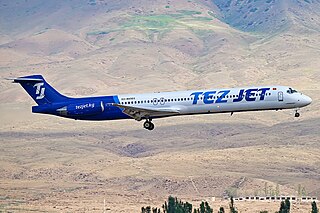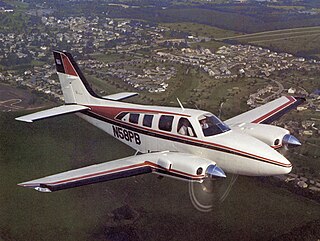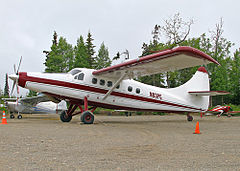
Trans World Airlines Flight 800 (TWA800) was a Boeing 747-100 that exploded and crashed into the Atlantic Ocean near East Moriches, New York, on July 17, 1996, at approximately 8:31 p.m. EDT, 12 minutes after takeoff from John F. Kennedy International Airport, on a scheduled international passenger flight to Rome with a stopover in Paris. All 230 people on board were killed; it is the third-deadliest aviation accident in U.S. history. Accident investigators from the National Transportation Safety Board (NTSB) traveled to the scene, arriving the following morning amid speculation that a terrorist attack was the cause of the crash.

The McDonnell Douglas DC-10 is an American trijet wide-body aircraft manufactured by McDonnell Douglas. The DC-10 was intended to succeed the DC-8 for long-range flights. It first flew on August 29, 1970; it was introduced on August 5, 1971, by American Airlines.

The McDonnell Douglas MD-80 is a series of five-abreast single-aisle airliners developed by McDonnell Douglas. It was produced by the developer company until August 1997 and then by Boeing Commercial Airplanes. The MD-80 was the second generation of the DC-9 family, originally designated as the DC-9-80 and later stylized as the DC-9 Super 80 . Stretched, enlarged wing and powered by higher bypass Pratt & Whitney JT8D-200 engines, the aircraft program was launched in October 1977. The MD-80 made its first flight on October 18, 1979, and was certified on August 25, 1980. The first airliner was delivered to launch customer Swissair on September 13, 1980, which introduced it into service on October 10, 1980.

The Hawker 800 is a mid-size twinjet corporate aircraft. It is a development of the British Aerospace 125, and was assembled by Hawker Beechcraft.

The de Havilland Canada DHC-3 Otter is a single-engined, high-wing, propeller-driven, short take-off and landing (STOL) aircraft developed by de Havilland Canada. It was conceived to be capable of performing the same roles as the earlier and highly successful Beaver, including as a bush plane, but is overall a larger aircraft.

The Beechcraft Baron is a light twin-engined piston aircraft designed and produced by Beechcraft. The aircraft was introduced in 1961. A low-wing monoplane developed from the Travel Air, it remains in production.

The Cessna 401 and 402 are a series of 6 to 10 seat, light twin-piston engine aircraft. All seats are easily removable so that the aircraft can be used in an all-cargo configuration. Neither the Cessna 401 nor the 402 were pressurized, nor were they particularly fast for the installed power. Instead, Cessna intended them to be inexpensive to purchase and operate.

Air Midwest Flight 5481 was a Beechcraft 1900D on a regularly scheduled passenger flight from Charlotte Douglas International Airport in Charlotte, North Carolina, to Greenville–Spartanburg International Airport in Greer, South Carolina. On the morning of January 8, 2003, the Beechcraft stalled while departing Charlotte Douglas International Airport and crashed into an aircraft hangar, killing all 21 passengers and crew aboard and injuring one person on the ground.

The Beechcraft 1900 is a twin-engine turboprop regional airliner manufactured by Beechcraft. It is also used as a freight aircraft and corporate transport, and by several governmental and military organizations. With customers favoring larger regional jets, Raytheon ended production in October 2002.

The Cessna 310 is an American four-to-six-seat, low-wing, twin-engine monoplane produced by Cessna between 1954 and 1980. It was the first twin-engine aircraft that Cessna put into production following its first twin, the Cessna T-50 manufactured for World War II.

The Learjet 25 is an American ten-seat, twin-engine, high-speed business jet aircraft manufactured by Learjet. It is a stretched version of the Learjet 24.

The Beechcraft Model 99 is a civilian aircraft produced by Beechcraft. It is also known as the Beech 99 Airliner and the Commuter 99. The 99 is a twin-engine, unpressurized, 15 to 17 passenger seat turboprop aircraft, derived from the earlier Beechcraft King Air and Queen Air. It uses the wings of the Queen Air, the engines and nacelles of the King Air, and sub-systems from both, with a specifically designed nose structure.
Empty weight (EW) is the sum of the ‘as built’ manufacturer's empty weight (MEW), plus any standard items (SI) plus any operator items (OI), EW = MEW + SI + OI. The EW is calculated for each aircraft series and each unique configuration of an aircraft and is confirmed by periodically weighing it. The "Operating empty weight" (OEW) is the sum of the empty weight and the crew plus their baggage.
The center of gravity (CG) of an aircraft is the point over which the aircraft would balance. Its position is calculated after supporting the aircraft on at least two sets of weighing scales or load cells and noting the weight shown on each set of scales or load cells. The center of gravity affects the stability of the aircraft. To ensure the aircraft is safe to fly, the center of gravity must fall within specified limits established by the aircraft manufacturer.
Northwest Regional Airport is a privately owned, public use airport 3 nautical miles (5.6 km) northwest of Roanoke, in Denton County, Texas, United States.

Soldotna Airport is a city-owned, public use airport located one nautical mile (1.85 km) southeast of the central business district of Soldotna, Alaska.

National Airlines Flight 102 (N8102/NCR102) was a cargo flight operated by National Airlines between Camp Shorabak in Afghanistan and Al Maktoum Airport in Dubai, with a refueling stop at Bagram Airfield, Afghanistan. On 29 April 2013, the Boeing 747-400 operating the flight crashed moments after taking off from Bagram, killing all seven people on board.

The 1972 Puerto Rico DC-7 crash was an aviation accident that occurred on December 31, 1972, in Carolina, Puerto Rico. As a result of inadequate maintenance, the aircraft's No. 2 engine failed after takeoff. After initiating a turn to return to the airport, the aircraft eventually descended into, or attempted to ditch into, the ocean a mile offshore. All five people on board died, including baseball legend Roberto Clemente. The crash site was listed on the US National Register of Historic Places in 2022.

On 13 April 2016, a Britten-Norman BN-2T Turbine Islander operated by Sunbird Aviation crashed about 1,200 m short of runway 7 at Kiunga Airport in the Western Province of Papua New Guinea. The plane pitched up right before the crash, then dropped its right wing and fell almost vertically to the ground. Eleven passengers and the 31-year-old Australian pilot, Benjamin Picard, were killed. Nine people died on impact, with other three declared dead on arrival at Kiunga Hospital.

On 4 August 2018, a de Havilland Canada DHC-2 Beaver aircraft operated by K2 Aviation crashed in poor weather near Denali, Alaska, United States. All five people on board survived the crash, but died before rescuers were able to arrive at the scene. The five people consisted of the pilot and four Polish tourists.

















